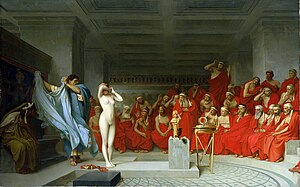|
Phryne Before the Areopagus
Phryne Before the Areopagus (French: Phryne devant l'Areopage) is an 1861 painting by the French artist Jean-Léon Gérôme. The subject matter is Phryne, an ancient Greek hetaira (courtesan) who was put on trial for impiety. Phryne was acquitted after her defender Hypereides removed her robe and exposed her naked bosom, "to excite the pity of her judges by the sight of her beauty."[1] The painting was exhibited at the 1861 Salon.[2] It is in the collection of the Kunsthalle Hamburg in Germany. Context Phryne was an ancient Greek hetaira (courtesan), best known for her trial for impiety in which, according to legend, the jury was persuaded by the sight of her naked breasts to spare her. Phryne was a popular subject for eighteenth- and nineteenth-century French artists, who emphasised her status as a courtesan and usually depicted her nude. From the mid-eighteenth century, artists such as Jean-Baptiste-Henri Deshays had depicted the trial of Phryne, and following Jacques-Louis David's charcoal drawing on the theme in 1818, they had increasingly focused on depicting her nakedness before her judges. Gérôme's version was immediately influenced by works by Charles Gleyre, in whose studio Gérôme had previously worked, and Victor Mottez.[3] PaintingGérôme's painting depicts Phryne standing nude, her hands covering her face.[4] Hypereides, shown standing to the left of the painting, holds Phryne's robe; the jurors sit on the right hand side.[5] Gérôme used Marie-Christine Leroux as a model for Phryne.[6] The work was exhibited at the 1861 Salon de Paris.[7] Since 1910 it has been in the collection of the Hamburger Kunsthalle.[8] ReceptionGérôme's Phryne Before the Areopagus was the most famous nineteenth-century depiction of Phryne. It was controversial for showing her covering her face in shame, in the same pose that he used in several paintings of slaves in Eastern slave-markets.[9] Driven by this controversy, Gérôme's painting was widely reproduced and caricatured, with engravings by Léopold Flameng, a bronze by Alexandre Falguière, and a painting by Paul Cézanne all modelled after Gérôme's Phryne.[10] By the end of the century, Gérôme's painting of Phryne and the various works inspired by it had made Phryne an "international cultural icon".[11] Bernhard Gillam made a famous caricature drawing in 1884 titled Phryne Before the Chicago Tribunal, where Phryne is replaced by the Republican Party presidential candidate James G. Blaine, covered in scandals, and Hypereides by the newspaper editor Whitelaw Reid. Teddy Roosevelt can be seen in the front row.[12] Another caricature followed in 1908, The High Tariff Phryne Before the Tribunal.[13]
References
External links
|
||||||||||||||



